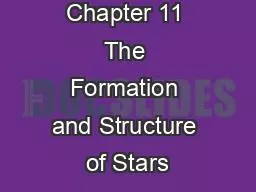

Guidepost In this chapter you will consider how the interstellar medium condenses into stars and what the conditions inside stars must be like How do stars form What is the evidence that stars are forming now ID: 794040
Download The PPT/PDF document "Chapter 11 The Formation and Structure o..." is the property of its rightful owner. Permission is granted to download and print the materials on this web site for personal, non-commercial use only, and to display it on your personal computer provided you do not modify the materials and that you retain all copyright notices contained in the materials. By downloading content from our website, you accept the terms of this agreement.
Slide1
Chapter 11
The Formation and Structure of Stars
Slide2Guidepost
In this chapter, you will consider how the interstellar medium condenses into stars and what the conditions inside stars must be like
How do stars form?
What is the evidence that stars are forming now?
How do stars maintain their stability?
How do stars make energy?
Slide311-1 Making Stars from the Interstellar Medium
Stars are being born, live a finite lifetime, and die.
Star d
eath
can ignite star birth.
Slide4The Formation of Stars
Stars are formed during the collapse of the cores of giant molecular clouds
Clouds must contract and heat up to ignite thermonuclear processes--
1 million K!
Slide5Contraction of Giant Molecular Cloud Cores
An external trigger is required to initiate the collapse of clouds
Slide6Slide7Shocks Triggering Star Formation
Shock wave moves towards interstellar gas cloud
Passes through and compresses gas cloud
Motion of particles in the cloud continue post-shock wave
Densest part of the cloud becomes gravitationally unstable
Stars are born within the contracting regions of the gas
Slide8Sources of Shock Waves
Massive stars die young → supernovae tend to happen near sites of recent star formation
Ionization fronts of hot, massive O or B stars producing UV radiation
Collisions of giant molecular clouds
Spiral arms in galaxies like our Milky Way are probably rotating shock-wave patterns
Slide9Shocks Triggering Star Formation (cont’d.)
Slide10Bow Shock
Slide11Sources of Shock Waves
Slide12Black Widow Pulsar
Slide13Slide14Protostars
Pre-birth state of stars
H → He fusion not yet ignited
Protostars:a forming star compressed enough to be opaque at all wavelengths, but not hot enough to generate fusion
“cocoon nebulae” hide the forming star
Fusion is the birth of a star!
Slide15Heating by Contraction
As a protostar contracts, it heats up
Slide16Slide17From Protostars to Stars
Higher-mass stars evolve more rapidly than less massive stars
Birthline: where stars are detectable at visible wavelengths
Slide18From Protostars to Stars (cont’d.)
The birth line: star emerges from the enshrouding dust cocoon
Slide1911-2 The Orion Nebula: Evidence of Star Formation
The visible nebula is only a small part of a vast, dusty molecular cloud
single O type star produces UV, causes glow
Slide20The Orion Nebula (cont’d.)
Infrared observations reveal clear evidence of active star formation deeper in the molecular cloud behind the visible nebula
Slide21The Orion Nebula (cont’d.)
Many of the young stars in the Orion Nebula are surrounded by disks of gas and dust
Slide22The Trapezium in the Orion Nebula
Slide23Open Clusters of Stars
Large masses of giant molecular clouds
Slide24Young Star Clusters
Ultraviolet radiation and strong stellar winds from young, hot, massive stars in open star clusters compress the surrounding gas
Slide2511-3 Young Stellar Objects and Protostellar Disks
Conservation of angular momentum leads to the formation of protostellar disks → birth place of planets and moons
Slide26Protostellar Disks and Jets – Herbig-Haro Objects
Accretion disks that often lead to the formation of jets (directed outflows, bipolar outflows)
Slide27Protostellar Disks and Jets – Herbig-Haro Objects (cont’d.)
Slide28Herbig-Haro Object HH30
Slide2911-4 Stellar Structures
Basically the same structure for all stars with approx. 1 solar mass or less
Slide30Hydrostatic Equilibrium
Imagine a star’s interior composed of individual shells
Within each shell, two forces must be in equilibrium with each other
Outward pressure force must exactly balance the weight of all layers above everywhere in the star
Slide31Hydrostatic Equilibrium (cont’d.)
Slide32Energy Transport
Energy generated in the star’s center must be transported to the surface is one of three ways
However, in stars only two energy transport mechanisms play a role
Inner layers: radiative energy transport
Outer layers (incl. photosphere): convection
Slide33Energy Transport (cont’d.)
Slide34Other examples
Slide3511-5 The Source of Stellar Energy
Stars produce energy by nuclear fusion of hydrogen into helium
In the sun, this happens primarily through the proton-proton (PP) chain
In stars slightly more massive than the sun, a more powerful energy generation mechanism than the PP chain takes over
Slide36The CNO Cycle
Slide37Energy Transport Structure
Slide38Discussion Questions
What are three different ways a giant molecular cloud can be triggered to contract?
How does the energy transport differ from a high-mass star to that of a low-mass star like the Sun?
Hint: see Figure 11-14
Slide39Discussion Questions (cont’d.)
If we could see in infrared light, what would a clear night sky look like? Are we missing out by being able to see only in visible light?
Hint : Think about views in and near the Milky Way versus far away from the Milky Way